On the Road is a weekday feature spotlighting reader photo submissions.
From the exotic to the familiar, whether you’re traveling or in your own backyard, we would love to see the world through your eyes.
It’s still winter in flyover country, then we jump back to fall color with BillinGlendale, Cheryl teaches us how to take better pictures of our pets, and OzarkHillbilly shares a very special place with us.
Albatrossity
The third week of our Wintry Mix in Flyover Country comes with a reminder that spring is on the way, and colorful birds will replace some of our more demurely-plumaged winter avifauna. But while they are still here, let’s appreciate these hardy companions before they start to head back to their summer homes.
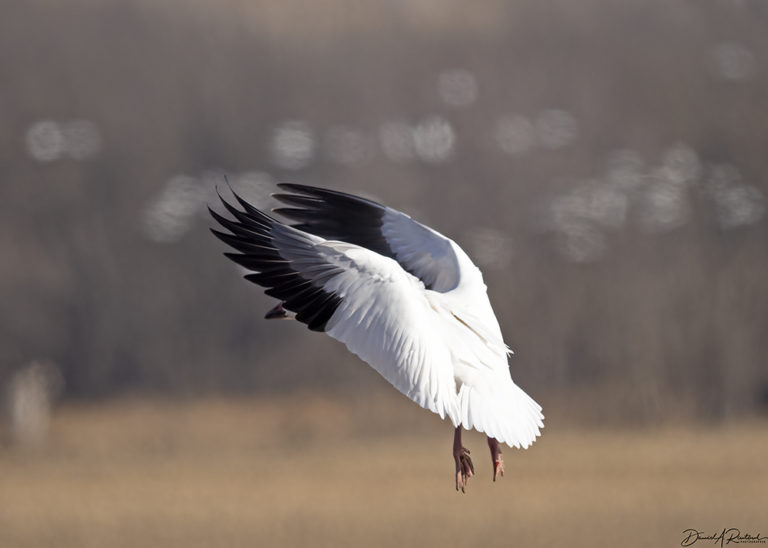
Seed-eating birds are abundant in this agrarian landscape, and they come in many sizes. This Snow Goose (Anser caerulescens) was one of a flock of several thousand, all hoping to find some waste corn in a harvested field. In decades past, colder winters and fewer corn fields meant that the Snow Geese would simply fly over us, and winter on the Gulf Coast. Climate change and human population growth has been good for this species, at least temporarily, as they can avoid a longer migration and spend more time fattening up for a shorter journey north in spring.
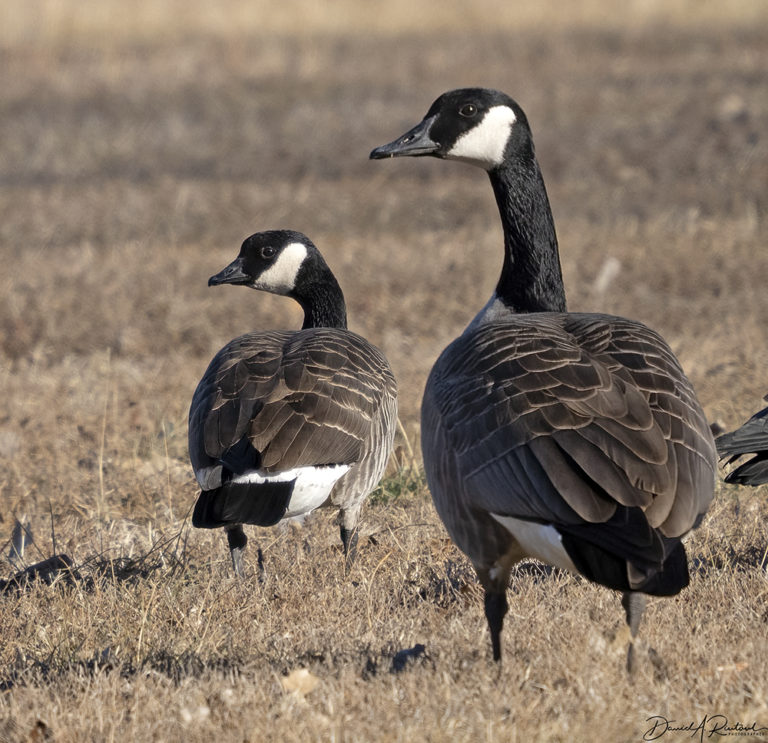
Other geese also enjoy the same corn diet, and some of them have become so acclimated to Flyover Country that they stay year-round. The bird on the right in this image is the ubiquitous Canada Goose (Branta canadensis), a year-round denizen on golf courses and city park ponds in much of the continent. The dinky bird on the left is a Cackling Goose (Branta hutchinsii), a smaller congeneric that summers in the high Arctic. These two species can be confused by many birders, but this picture shows the best way to distinguish them. Canadas have long bills that flow uninterruptedly from their forehead, and Cacklings have stubby bills that look like they were shoved into their faces.
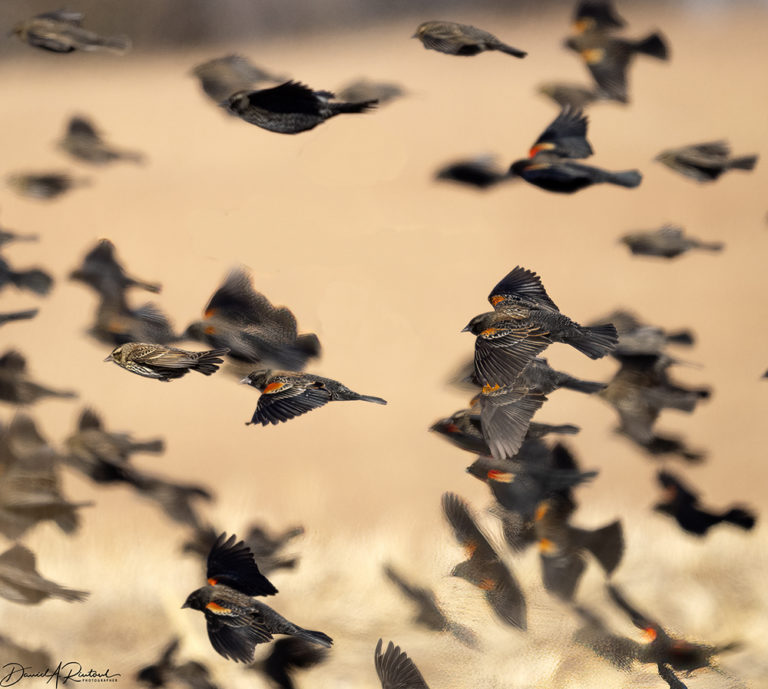
The same cornfields also host flocks of Red-winged Blackbirds (Agelaius phoeniceus), which is another species benefitting temporarily from climate change. In the past the biggest flocks wintered further south of here, and it was unusual to see very many in the winter. The first migrants of the spring, usually males, showed up in March. Now both males and females spend the winter in Flyover Country, and the spring songs will be heard well before March.
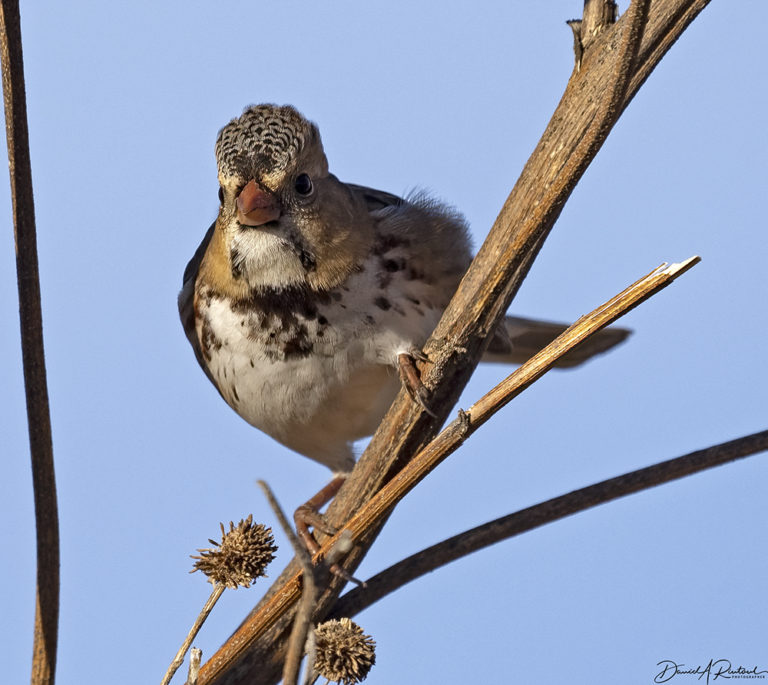
Sparrows make the winter birdwatching here more rewarding, as they are abundant, diverse, and often frequent bird feeders where they are visible and photographable! Harris Sparrows (Zonotrichia querula) have the interesting habit of feeding in weedy sunflower-rich patches for most of the winter, and then “moving to town” for the last couple of weeks before they migrate, frequenting suburban and urban bird feeders to the delight of the human residents.
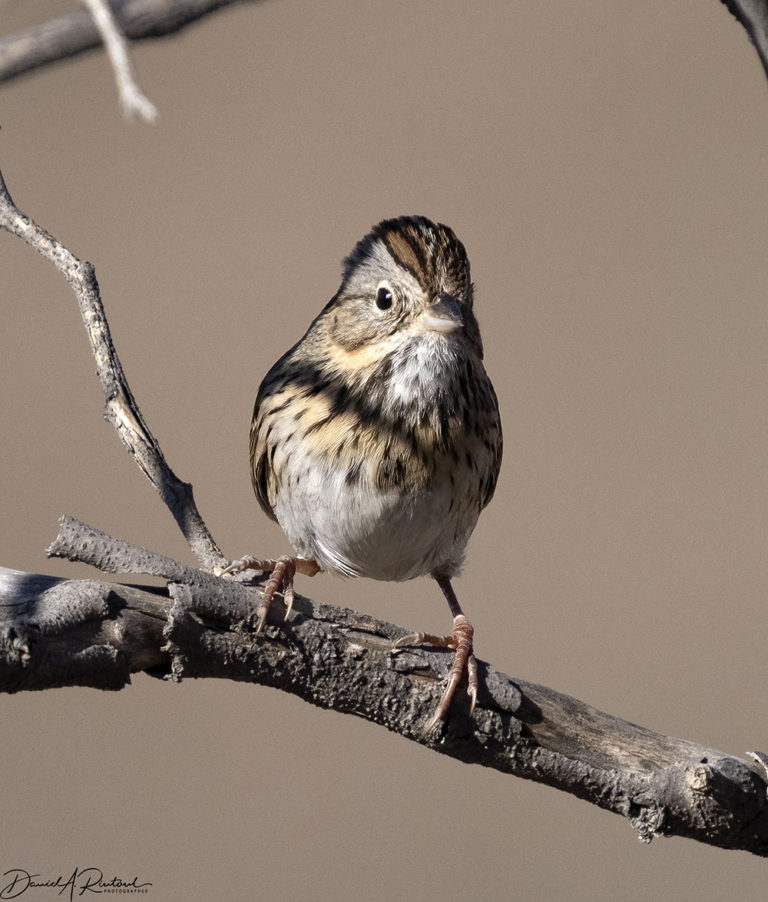
Lincoln’s Sparrows (Melospiza lincolnii) also seem to be more common in winter here in recent years, and their subtle elegant colors are underappreciated (as is the case with most sparrows). Unlike many of our winter sparrows, these are generally solitary, so it is always a treat when one pops up out of a brushpile or weedpatch.
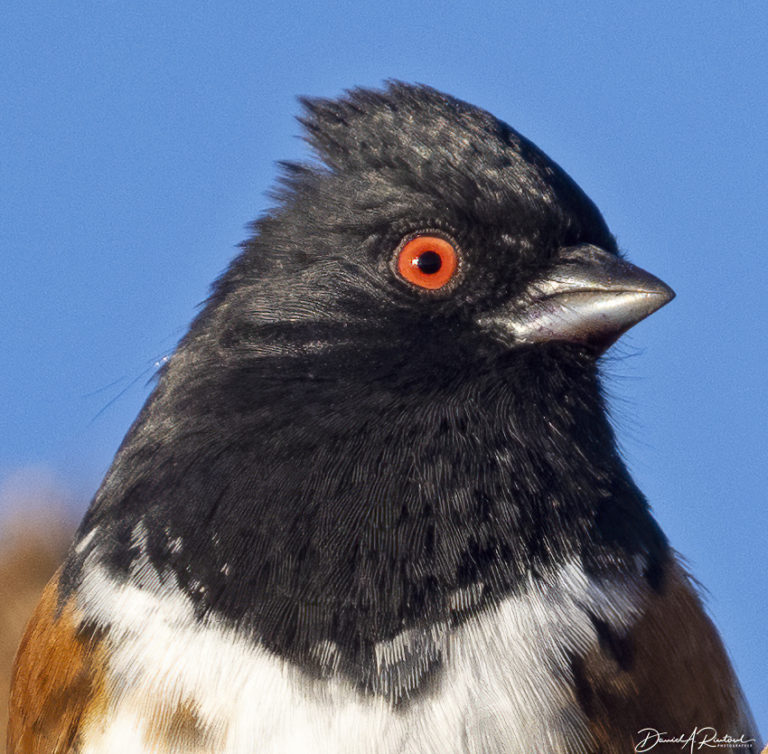
Most folks don’t consider towhees to be sparrows, but they are, despite their relatively imposing physiques. Winter means that our local towhees are Spotted Towhees (Pipilo maculatus), down from the Dakotas for the warm winter weather here.
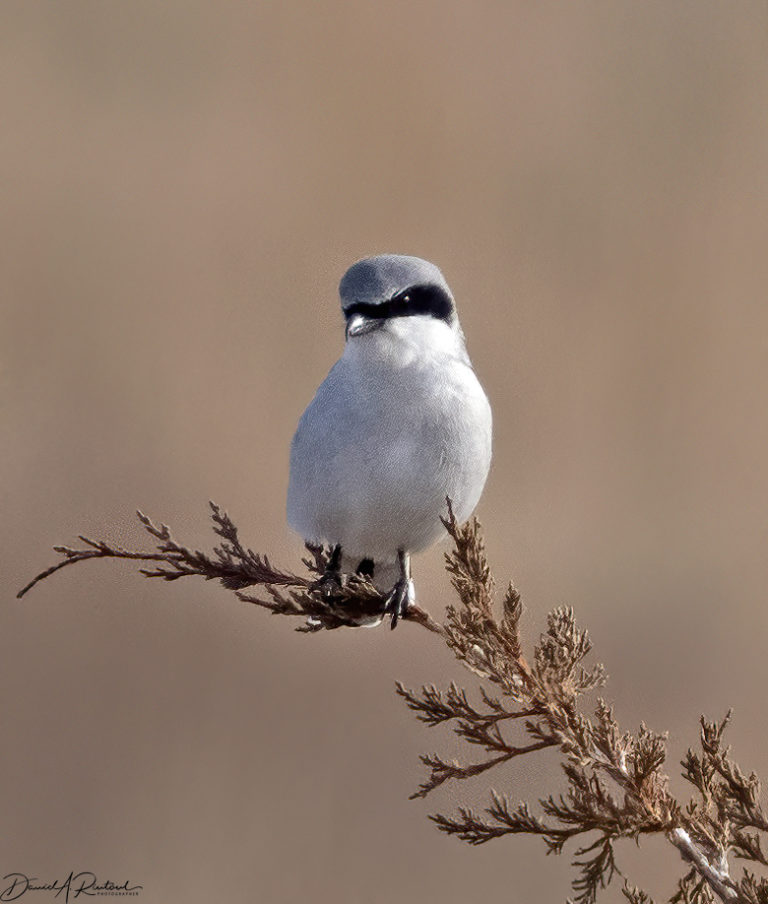
Worldwide there are 34 species of shrikes, but we only have two expected species in North America. I was thrilled to see this Loggerhead Shrike (Lanius ludovicianus) in mid-January, because it had been 18 years (!) since I last saw one in the winter here. For reasons unknown, this species, formerly uncommon but regular here in the winter months, has disappeared from much of Flyover Country as a wintering resident. Northern Shrikes, formerly rare here, have been the default ID whenever I see a shrike in the winter months. Interestingly, a week later I found another Loggerhead Shrike about 40 miles south of this sighting, so maybe that is a trend, Even if not, it was a grand sight to see.
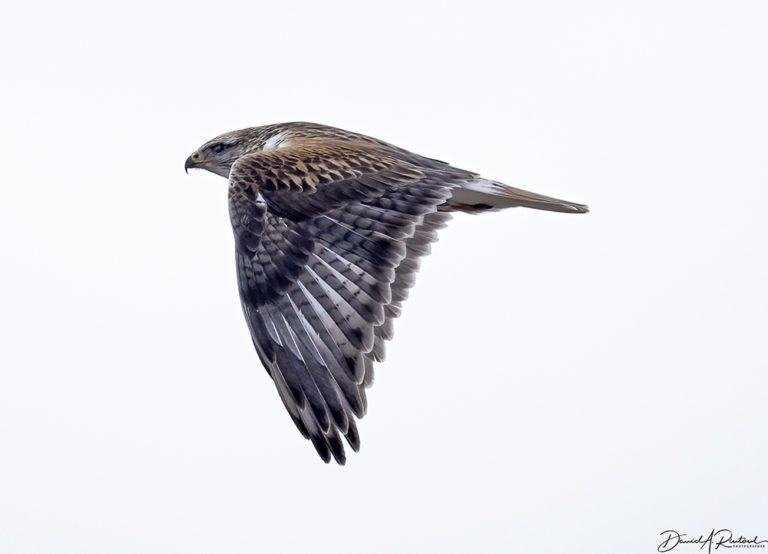
Another grand sight was a Ferruginous Hawk (Buteo regalis), a declining species across much of its range, and definitely not expected here in the tallgrass region. Prairie dogs are the major food for this species, and prairie dogs are short-grass prairie inhabitants. There are apparently plenty of other tasty rodents here in the winter, however, and this gorgeous adult was hopefully making them a bit less abundant.

Smaller and daintier than the Ferruginous Hawk, Rough-legged Hawks (Buteo lagopus) come in dark or light morphs. The dark ones are truly dark, but relatively uncommon, so I was happy to find a cooperative one for a change. Usually I see them floating high above a pasture, either on a cloudy day or between me and a bright sun, making photography a fairly frustrating enterprise.
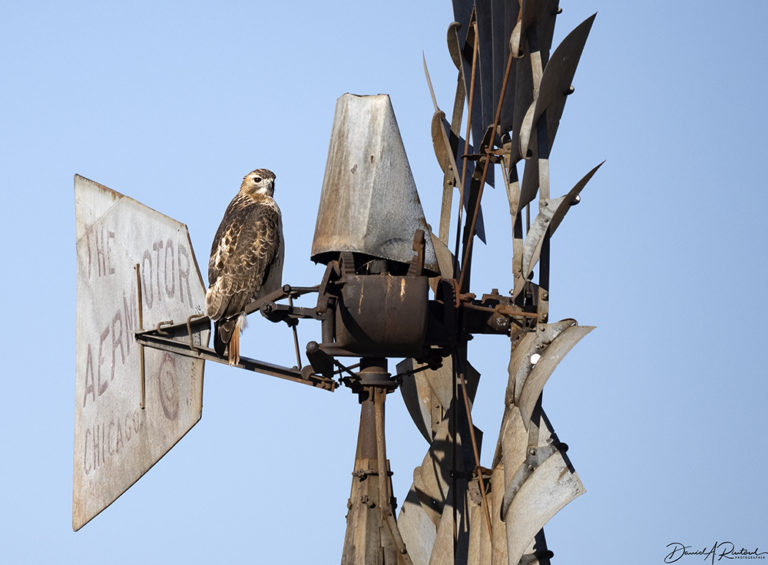
Our final image from Flyover Country features one of the iconic sights on the Great Plans, an abandoned metal windmill. The Aermotor company was founded in 1888 and is still in business, but this model has seen better days and now functions mostly as a hunting perch for a Red-tailed Hawk (Buteo jamaicensis). Little-known fact: Aermotor produced the lens mounts for the top-secret Norden bombsight in WWII.

OzarkHillbilly
Thanx.
SiubhanDuinne
I never, ever tire of looking at your beautiful photos and reading your informative commentary. Thank you again.
sab
I am one of those folks who never considered towhees as sparrows, so live and learn on this full service blog.
I ususally think of towhees as cute, but that one looks fierce.
Rob
That towhee does look fierce. The Harris’s Sparrow looks like it means business. The Rough-legged Hawk almost looks like the Lincoln’s Sparrow of buteos… “I’m not here, this isn’t happening”
Albatrossity
@Rob: Yeah, the look on that Rough-legged Hawk’s face reminds me of a dog that got caught digging through the kitchen garbage!
Rob
@Albatrossity: “I didn’t do it!”
Or, paraphrasing what twitter.com/darth would say, THE HAWK IS INNOCENT
SteveinPHX
Many thanks for the photos and text!
arrieve
That flock of red-winged blackbirds is just amazing. They’ve just started arriving here (NYC) as a sure sign that spring is coming, but I usually only see them in ones and two. It’s interesting that the flock in the picture looks like males-only. Where are the scrawny-looking, striped, female blackbirds?
Albatrossity
@arrieve: The flocks here right now are nearly all females. The males migrate north earlier, and three are probably in Nebraska currently. The females, being more sensible, are still here.
Miss Bianca
I can’t believe you’ve made me seriously consider Kansas as a destination/vacation spot, and yet, here we are.
Hmm…riding in the Flint Hills…
One of the Many Jens
I so love looking at all of your photos. Thank you so much for sharing them!
Rob
@Albatrossity: @arrieve: We encountered an all-female flock of Red-winged Blackbirds migrating just outside of Washington, DC, this morning. So they (females) are on their way to New York City.
J R in WV
Amazing photo of red-winged blackbirds. We have them here, I see them as solitary birds on fence posts along hay meadows, never as a flock, or even as pairs much.
Thanks again for sharing your great work and knowledge of birbs!!
Madeleine
Like others, I was surprised by the large flock of red winged blackbirds. There are so many striking and unusual shots in today’s group, for which I thank you.
My husband and I were happily surprised to see a red tailed hawk close by on the roof of the neighboring apartment building last week. We had the unusual opportunity to see its back, which my husband described as “pied.”
dkinPa
@Miss Bianca: I was just thinking the same thing!
Thanks, Albatrossity, for your photos and commentary.
Albatrossity
@Miss Bianca: If you time it right, you can also catch this cultural event. Symphony in the Flint Hills